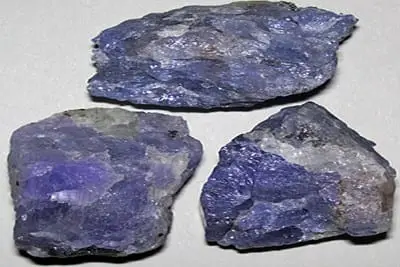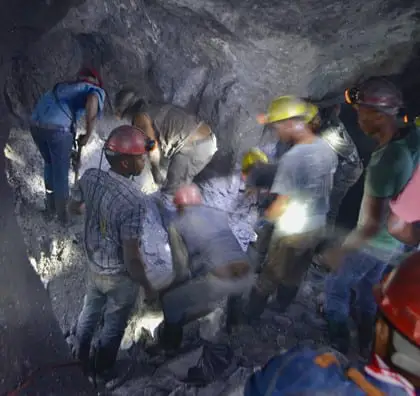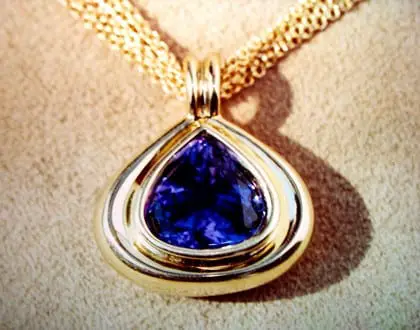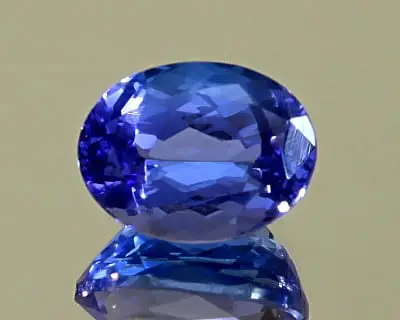Tanzanite is the trade name of the blue and violet variety of zoisite (calcium aluminum hydroxyl sorosilicate). It was discovered in 1967 by Ndugu Jumanne Ngoma. It is one of the rarest gemstones in the world and is thought to be 1000 times rarer than diamonds. It was named after Tanzania, the country in which it was discovered, and popularized by Tiffany and Company. Today, tanzanite is the second most popular blue gemstone, next to sapphire. It was designated as a modern birthstone in 2002, owing to its growing popularity.
Maasai legend has it that the stone came into existence when the Merenani hills were struck by a bolt of lightning. According to the tribesmen, the heat from the fire that ensued turned the brown zoisite rock into the gemstone’s blue crystals. Tanzanite shows the property of pleochroism. Pleochroism is that physical property by virtue of which a material appears to be of different colors when it is viewed from different crystallographic angles. Depending on crystal orientation, it can appear in 3 different colors – blue, violet or burgundy. So it is called a trichroic gemstone. The blue color is ascribed to the small amounts of vanadium contained in the zoisite mineral.

Tanzanite-containing rocks from the Merelani Hills
Tanzanite is mined at only one location in the world. The mines are located in the Merelani Hills over small area only 4 kilometers wide and 2 kilometers long. They lie at the foot of Mount Kilimanjaro, in the Manyara Region of North Tanzania. After its discovery about 2 million carats of tanzanite were mined until 1971, when the Tanzanian government nationalized the mines. This was followed by years of hardly any mining activity. In 1990, the government split the mines into blocks A, B, C and D. Blocks A and C were entrusted to large operators, and B and D were reserved for local miners.
THE MINING OF TANZANITE

Local miners searching for tanzanite
In the initial days after its discovery, tanzanite was collected easily from the surface. This however didn’t last long, and pits and tunnels were to be created. Tanzanite exists upto 2000 meters below the ground. The deeper the mining level gets, more sophisticated infrastructure is required to provide ventilation, watering and dewatering, to ensure the safety of miners, and to ensure successful extraction. Tanzanite is mined and made ready for the market in a long and complex process.
Finding Boudins: Tanzanite formation spans more than 500 million years. It was created by massive tectonic plate activity and intense heat in the area around Mount Kilimanjaro. Deposits are naturally located in the hinges of isoclinal folds of rock. It is mined from an underground igneous rock called pegmatite, which is found in sheets of rock called ‘veins’. Pegmatite veins that have become stressed over time break down into smaller sausage-shaped pieces called ‘boudins’. Boudins form straight, horizontal shafts within the earth. Tanzanite gems are found within small pockets inside these boudins. Not every boudin contains tanzanite. Some may contain other minerals like quartz and pyrite. The most arduous part of tanzanite mining is finding these small pockets.
Setting Up Explosives: Tanzanite mining occurs in pits and tunnels, which are sometimes several hundred meters below the ground level. TanzaniteOne – the world’s largest Tanzanite mining company which extracts the mineral from block C- has shafts that reach depths of 800 meters.
Once the pegmatite rocks containing the gemstone are found, they are to be fragmented down into smaller chunks. This is to be accomplished using explosives like dynamite.
Fragmenting the Rock: The dynamite is set off to break the rock down into smaller chunks. This is often heard and felt as a “Big Boom” even at far distances. The explosion causes carbon dioxide to build up which is to be removed if mining activities were to be continued. Oxygen pipes are let down into the mines to let fresh air in. These help remove carbon dioxide and increase oxygen levels.
Sorting:
· Before a gem worth selling can be acquired, the mineral is to undergo several steps of sorting and processing.
· The local miners sort the mineral out manually. On the other hand, the large operators including foreign investors use fully automated optical sorting and primary grading equipment.
· First of all, the gems are picked from the shaft.
· Then they are carried to a sorting house. Cleaning and weighing of the mineral is done here.
· Non-gem material is removed from the gems. This is followed by a process called cobbing, during which minerals mixed with the mined stone are separated from the gem. This is often carried out using a handheld hammer. Other methods like magnetic separation can also be used.
Heat Treatment:
· Trichroic tanzanite is rendered dichroic through heating. During this process, the stone’s brown or burgundy color component is removed to produce a stronger blue-violet gemstone. Tanzanite which reflects only blue and violet is considered to be of higher value.
· Before heating, it is to be ensured that the stone does not contain any cracks or bubbles. Cracks and bubbles can increase in size and even shatter the entire stone upon heating. Heat treatment is carried out at temperatures between 370 and 390 degrees Celsius for about 30 minutes in a furnace.
· Some stones found close to the surface may not require heat treatment as they are already dichroic. This is probably the result of wildfires that heated the stones underground.
Further Processing:
· A thin layer of cobalt may be applied to the surface of the gem to improve its color.
· Cobbed gems are graded to divide them into groups of different quality.
· Gems of good quality are processed further for grading on the basis of color, clarity and carat.
· TanzaniteOne has developed a color-grading system of its own to assess the quality of the gemstone. It divides tanzanite colors into a range of hues between bluish violet, indigo and violetish blue.
· Clarity grading is based on the eye-clean standard. A gem is regarded flawless if inclusions cannot be seen with the unaided eye (of normal vision). Gems with inclusions that are visible through the naked eye are traded at deep discounts.

A gold chain with a tanzanite-embedded locket
Cutting and Polishing:
· The processed tanzanite is examined to determine the best shape and cut that gives the gem the most brilliance. The planes against which the rough stone needs to be cut is marked.
· ‘Bruting’ is the process during which the corners of the rough stone are made round using a bruiting stick and a spinning wheel.
· When the thickest part of the gemstone is made perfectly round, it is cut into a desired shape.
· The cut tanzanite is polished by pushing it against a spinning wheel. This gives the stone its final facets and renders it ready for sale or to be set in jewellery.
Testing of Spare Minerals: The spare material is taken into laboratories. Here these are tested to examine whether they can be processed into high quality gemstones. The other spare minerals may be used for educational and research purposes, or displayed in museums.
More than 70,000 people are supported and employed by the tanzanite mining, cutting and trading industry. The mining is still largely carried out by local individuals using artisanal method, although the operations at TanzaniteOne’s Block C have state-of-the-art facilities. Many of the smaller mines have very basic air supply systems and hardly any facilities to dig further without significant investment. The most basic mines only have a hole in the ground through which miners descend using a ladder or rope. Most local miners work in cooperative groups. They share the tanzanite mined equally among the members of the cooperative. Many of them have second jobs to keep their families out of poverty during times when no gemstone is found. This is becoming more prevalent due to the difficulties of mining over 400 meters below the ground, without the aid of effective machinery.
Tanzanite mining is a major source of revenue for the government of Tanzania. Over the years, it has enforced several reforms. These include the construction of a wall around the mines and the installation of security cameras to monitor the movement of the gemstone. The government seeks to reduce smuggling and tax evasion and to collect its fair share of revenue from this industry. It has also attempted to increase the opportunities for artisanal miners and improve the facilities available to them for mining. Local miners are allocated demarcated areas, and external interventions in these areas are controlled.
Nevertheless, the ownership of Tanzania’s minerals and governance over the extraction of tanzanite have been intensely debated in recent times. There has been growing tensions and conflict between the small scale artisanal and large scale industrial mining sectors. The government’s inclination towards privatization has only aggravated the tensions between the different parties involved. The issue of foreign large-scale mining companies appears to be one of the threats to Tanzania’s social and political stability since its independence.
It is assumed that at current rates of production, there is enough tanzanite to be mined for another 30 years.




